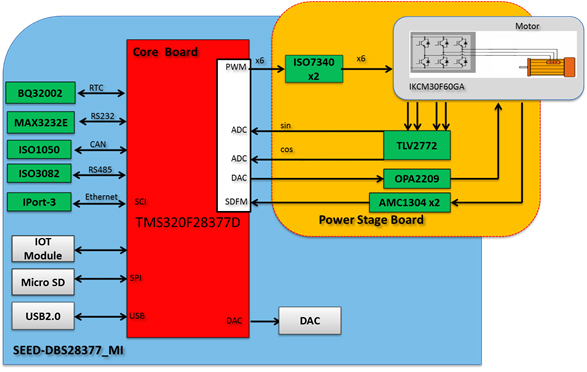As a device that indirectly compensates motor speed change, a servo motor is motor that controls the rotation of mechanical components in a servo system. Although the servo motor has been extensively used in industrial control, there is always a more convenient way to quickly design a servo motor control system.
Total solution for servo motor industrial control
A servo motor can accurately control motor rotation speeds and turn voltage signals into torque and rotation speed to drive the controlled object. The rotor of a servo motor is controlled by input signals with a quick response. As an execution component in an automatic control system, the servo motor, characterized by a small mechanical time constant, high linearity, and low starting voltage can convert the received electrical signals into the motor axle’s position shift and angle outputs. Currently, there are alternative current (AC) and direct current (DC) servo motors. When the signal voltage is zero, the servo motor will not rotate, and the rotation speed evenly reduces as the torque increases.
A servo system is an automatic system that can randomly change the output energy, including position, direction, and status, of an object as commanded (specified value). In a motor servo control, sensors are installed on the motor and the controlled object. The detection results will return to the servo amplifier for comparison with the command. Therefore, as a servo motor is controlled by feedback signals, it is different from a stepper motor controlled by input pulse signals.
A servo motor comprises the following three devices: (a) The “commanding device” (controller) that gives motion command; (b) the “controlling device” (servo amplifier) that commands the motion of a servo motor with the signals from the commanding device and the feedback signal; and (c) the “driving, sensing device” that drives an object with the power supplied by the servo amplifier and detects its status.
A motor requires speed feedback in a transmission job. After receiving the speed feedback signal, the controller controls the motor driving mechanism to stabilize rotation speed at the target speed. Conversely, we can select a transmission mode based on the speed. Common speed feedback components include the rotary encoder, Hall effect sensor, and resolver transformer (or simply resolver).
Functionally, although all three above functions can feedback speed, the code disc in encoders breaks easily due to vibration in the absence of higher-level protection. Despite the better resolution, repair frequency is high to affect quality and reliability. The Hall effect sensor is cheap, but its resolution is lower, thus reducing control accuracy. In addition, as magnetism reduces after heating, the Hall effect sensor has a shorter lifespan. As the rotor and the stator of revolver are separated, they are contactless. Together with the brushless design, the revolver has a very high protection level against strong vibration, water and oil contamination, thus delivering a lifespan over decades. In addition, dedicated converter chip decoding can convert output analogue signals into digital signals that can compete with the accuracy of rotary encoders. Therefore, the revolver is an ideal speed feedback component.
Arrow SEED introduces an industrial control solution using the SEED-DBS28377_MI and SEED-DBS28377_CORE. This solution realizes a four-revolver servo motor interface to provide an ideal control platform for the feedback control of revolver servomotors. Based on the latest TI C2000 platforms, by integrating the needs for motor control, industrial automation, and power line communication, Arrow SEED launches this universal, easy to deploy, and fit for secondary development total solution suitable for industries, so as to deliver an excellent control platform for industrial automation by maximizing industrial automation and power line communication.

The SEED-DBS28377_CORE is equipped with the TMS320F28377D MCU and 64MB SDRAM. The SEED-DBS28377_MI is equipped with interfaces including DA, USB, SCI, CAN, Ethernet, motor driver + revolver analogue signal collection + ADC, SD, IoT module, and 10-pin JTAG simulation, LED buttons, and power input.
This control system supports a wide variety of motors: three-phase brushless revolver servo motors that are 24V DC, 6-core, 3-phase, 20-30W wattage, and 3000-4000 rpm. It only needs to connect a motor with the system with the corresponding motor driver board. Power connections can refer to the power source design of TI control board solutions.
As a total solution for product development, apart from controlling servo motors more easily, this solution is equipped with a wide variety of interfaces enabling users to quickly develop IoT products. For any equipment, such as machine tools, printing equipment, packaging equipment, textile equipment, laser processing equipment, robots, automated production equipment, requiring power and asking for high accuracy, this servo motor control solution will be an ideal option for relevant applications.


